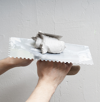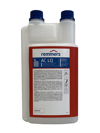Liquid component for acrylic-bound mortar

Joints fulfil different functions in a building and must therefore have very different characteristics according to the respective requirements. This applies not only to the visual properties, but also to the physical, mechanical and, above all, moisture-related properties. An intact joint network is a prerequisite for a driving rain-proof façade. Penetrating moisture leads to increased frost stress and a reduction in thermal insulation - both of which must be adapted to the existing building fabric and carefully avoided. Remmers jointing mortars cover a wide range of binder systems, grain sizes and strengths as well as a choice of colours and capillary-blocking properties. They can therefore be selected at any time to suit individual areas of application, conditions and requirements.
Mineral-bound restoration mortar systems
The Remmers Restoration Mortar System was specially developed for additions to mineral building materials or for their replacement. As mineral building materials differ greatly in their composition (structure, pore space, colour, grain size, etc.) and it is important to match the replacement mortar to the substrate in order to ensure long-term durability, Remmers offers a wide range of adaptation options to suit a variety of applications. The structured composition enables applicators and planners to select an optimally adapted restoration mortar.
- All cementitious restoration mortars are available in two strength levels
- All restoration mortars are available in three grain sizes for visual customisation

-
Binder
-
Binder compound
-
Priming and restoration mortar
Acrylic-bound supplementary mortar
Mortar systems based on aqueous acrylic dispersions have been systematically analysed and evaluated at the Materials Research and Testing Institute of the Bauhaus University Weimar (MFPA Weimar) since 1995. Based on the knowledge gained, special mortars have been developed that are superior to classic lime-cement based mortars, especially for the restoration of limestone, but also for some special tasks in the context of brick restoration and the re-pointing of press joints. This is due to a number of special properties of these mortars.

Advantages of acrylic-bound finishing mortars
- Structure and colour matching to the original substance
- Reproduction of the physicomechanical properties of the original substance through targeted formulation of the dry mortar, e.g. pore volume
- No reworking of defects required
- High flank adhesion
- Can be worked towards ‘zero’ levelling
- Reversible
- Free from mineral binders
Lithos Arte
Special requirements call for special solutions!
When high layer thicknesses need to be realised in just one work step, conventional restoration mortars reach their limits. For such extreme requirements, such as those required for repair work on profiles, ornaments, sculptures or replicas, a stone replacement material with special properties is needed.
Lithos Arte has been specially developed for this challenging task. The 2-component material consists of natural stone sands and a mineral binder. The special formulation enables unusually fast, stress and shrinkage-free hardening with excellent substrate adhesion. High layer thicknesses can be built up in a single work step.

Unlike alternative stone replacement materials, Lithos Arte does not require additional moisture and does not interfere with direct sunlight during the setting process. Surface shaping work, e.g. embossing, scratching or chiselling, can begin just a few minutes after application. Lithos Arte does not turn grey or yellow with age after installation. If required or desired, a final water-repellent or colouring finish can be combined after complete drying.
Re-plastering contaminated substrates
Buildings change. Over time, dirt and air pollutants are deposited on the façades. Moisture penetrates. When a refurbishment is due, the façades are usually cleaned, but this is usually not enough. Over the years, salts have built up that resist cleaning. If the plaster is renewed in such cases, the base coat and top coat should be designed in such a way that they can deal with this damage potential as permanently as possible. Remmers restoration plaster systems are ideally suited and proven.
The permanently water-repellent and highly permeable restoration render allows the masonry to dry out, but retains the salts to prevent efflorescence. If there are a lot of salts present, the substrate can be levelled with (porous) base render, which gives the salts the opportunity to crystallise without causing any damage. Alternatively, Remmers Compressed Plaster can be applied as a genuine dehumidifying plaster that is diffusible and capillary-active. It ensures permanent moisture regulation and, with a pore volume of over 60 %, offers ample space for the storage of salts.

WTA Sacrificial plasters
If extremely high levels of salinity are present, it is recommended to work with sacrificial plasters, also known as compressed plasters, as an alternative to permanent one or two-layer restoration plaster systems to reduce the salt content in areas close to the surface. Depending on the type and quantity of salts, the service life of such plasters is many years. Sacrificial plasters are genuine dehumidifying plasters, open to diffusion and capillary-active. With a pore volume of over 60 %, Remmers Compressed Plaster has a significantly higher pore volume than salt storage plasters in general.
Unlike restoration plaster, it does not have a water-repellent finish in favour of dehumidification and desalination. Compression plasters therefore have plenty of space for the storage of salts and the transport of moisture. This means that the time of ‘sacrifice’ can be delayed as long as possible. Remmers Compression Plaster is also suitable for the repair of wall paintings damaged by moisture and salt.

Rendered façades based on historical models
The use of traditional materials and application techniques is one of the basic premises in the restoration of listed buildings. As long as no excessive salt and moisture influences are to be expected, the use of traditional materials, including the object-specific recreation of historical formulas, is the primary restoration objective. Old mortar compositions can be recovered with the Remmers Historic Mortar System.
This applies to almost all types of historical formulations. From dry slaked lime plaster mortar to Roman cement mortar, classicist stone plasters and brick chippings from the middle of the 20th century. We formulate on the basis of analyses carried out in each individual case and our many years of experience from 75 years of active commitment to the preservation of historical monuments.

We therefore make our knowledge available to anyone who wants to counteract the loss of historic plaster textures and formulas and the associated loss of historic mortars.
Romantic cement
Roman cement was first used by John Smeaton in 1774 during the construction of the Eddystone lighthouse in England. He had previously discovered that the usual addition of pozzolanic (volcanic) additives to lime to increase its strength could be dispensed with if either brick dust was added during the burning process or lime contaminated with clays was used. This realisation quickly spread from England to other countries, with the result that Roman cement became the preferred binder in Europe from 1800 to 1850. In the decades that followed, it faced strong competition from Portland cement, which also originated in England, until its use practically dried up completely with the outbreak of the First World War.

Roman cements were often used as a thin layer of mortar with a relatively high cement dosage. The nevertheless low diffusion resistance and the comparatively high porosity ensured high durability. In order to fulfil the requirement of repairing historical Roman cement mortar in a material-appropriate manner, Remmers uses the two available raw material sources in Poland and France to formulate the corresponding products. Due to the large number and importance of the buildings on which the Roman cements played a significant role in the 19th and early 20th centuries for plastering and façade ornamentation, and the highly interesting properties of these binders in terms of building physics, the European Union has funded two successive projects to revitalise Roman cement technology: ROCEM (2003 - 2006) and ROCARE (2009 - 2013), in which Remmers was involved as a partner.
Stucco renewal and repair
Stucco elements give façades a special touch. They symbolise noble and traditional craftsmanship. Building façades decorated with stucco characterise many historical towns. However, stucco is not only understood to mean the opulent sculptural embellishments of the Baroque and Rococo periods, but also, for example, simple cornices, window mouldings, pilaster strips and the like. In the production of stucco, a distinction is made between traditional moulding on site and prefabricated stucco profiles and ornaments.
Remmers has solutions for both production methods that fulfil modern requirements in terms of workability, speed and durability.

Reproducing originals
There are many good and legitimate reasons for making moulds of valuable originals: From the restorer to the archaeologist, the museum curator to the artist who wants to reproduce his designs: they all work with silicone moulding compounds.
Remmers Silicone AFM is a highly elastic, condensation-curing silicone moulding compound with high tear resistance and has been specially developed for the production of universally usable casting moulds. It shows excellent reproduction accuracy and is suitable for moulds of all levels of difficulty.

Thanks to its high elasticity and good release properties, the material can be easily removed from the model and is therefore designed for the highest possible moulding frequency and accuracy. To increase stability, the flowability of the silicone moulding material AFM can be reduced by adding thickening additive AFM. This means that skin moulds can also be created on non-flat or vertical mould surfaces using the spreading method without the impression material running or sagging. The mould can be poured with different materials: pourable mortar/stucco mortar is usually used for replication.
Other materials such as plaster, clay, wax and casting resins such as polyester and polyurethane can also be used to fill the silicone moulding compounds. However, casting resins limit the moulding frequency.
Brochure "Preservation of historic buildings"

Peace of mind guaranteed
Benefit from our expert advice, our promise of optimum safety for our extensive product range, and our express delivery service.
Express delivery
Our express delivery is the ideal service for anyone who needs their order to be delivered fast.
Specialist representatives directly on site
Our specialist representatives are on hand to provide you with personalised support and advice – wherever you are.
Extensive product range
From building and floor protection products through to wood preservatives, we have everything you need!
Systems with Remmers guarantee
You can be sure of a reliable and high-quality solution for every application.















